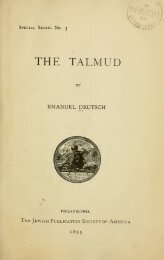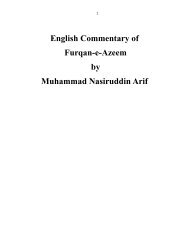- Page 2:
Introduction Chapter II : His Geniu
- Page 6:
D. Imam Musa loves ‘Ali Bin Yaqte
- Page 10:
his own generous abilities. In this
- Page 14:
through it was forgiven.”[3] In h
- Page 18:
the Prophet). They are the life shi
- Page 22:
Bayt toward them, it was severe and
- Page 26:
This sound way was chosen by some p
- Page 30:
They say: “His inclination and op
- Page 34:
message to be burnt in a fire was i
- Page 38:
Chapter II : His Genius and Superio
- Page 42:
whom human history has ever known i
- Page 46:
Abu Hanifa was among those who beli
- Page 50:
prohibited. He permitted them to be
- Page 54:
This means that all signs and quali
- Page 58:
is achieved when it is good. Surely
- Page 62:
nature?" The boy turned to him and
- Page 66:
Hearing, Knowing." Then he turned t
- Page 70:
the intellectual life in Islam. Aft
- Page 74:
When you meet him, recite my greeti
- Page 78:
They found in the grandson of the g
- Page 82:
[1] Al‐Irshad. A'lam al‐Wara. A
- Page 86:
1. Kitab Ma'ani al‐Qur'an (a book
- Page 90:
[3] Al‐A'lam, vol. 1, p. 186. Al
- Page 94:
The Authority fears the Imam's Scho
- Page 98:
"O my little son, whoever unveils (
- Page 102:
them, who dedicated themselves to i
- Page 106:
nor rough. His eye does not precede
- Page 110:
liberality, kindness to men, steadf
- Page 114:
far from all the factors of decline
- Page 118:
1. He must have the comprehensive c
- Page 122:
justice. This self immunity arouses
- Page 126:
‐Do they choose a righteous perso
- Page 130:
guided (people) by Our commands, an
- Page 134:
"Accordingly, how do they choose th
- Page 138:
to whom men should resort. All the
- Page 142:
has planted, then let him follow 'A
- Page 146:
Dawud Bin Kuthayr hurried to Imam A
- Page 150:
with one of your offspring for the
- Page 154:
"He is Isma'il," they all said. "O
- Page 158:
Imam al‐Sadiq has praised his son
- Page 162:
his time and was among the great, g
- Page 166:
19. Al‐Sayyid Kazim al‐Yemeni "
- Page 170:
[2] Al‐Sawa'iq al‐Muhriqa, p. 1
- Page 174:
sent him a purse in which was a tho
- Page 178:
9. He is among the Imams of Muslims
- Page 182:
two of them: 1. Deduction is obliga
- Page 186:
Without doubt, the stars have not c
- Page 190:
and the hadith always magnify the a
- Page 194:
"Do you thing that you are a small
- Page 198:
countries. If clouds touch the surf
- Page 202:
Imam Musa, peace be on him, has quo
- Page 206:
inspiration, then they must turn aw
- Page 210:
Nevertheless, they associate others
- Page 214:
2. They have faith in Allah. 3. The
- Page 218:
abundant reason is the best thing w
- Page 222:
and ask Him to perfect his reason.
- Page 226:
[1] Al‐Waafi. determination and c
- Page 230:
greatness, My power, My radiance, a
- Page 234:
"Then gently advise him. If his hea
- Page 238:
eternity. His staying deters ambiti
- Page 242:
informs none of His creatures; He a
- Page 246:
2. Al‐Fakhr al‐Razi Explaining
- Page 250:
faith justice and love prevail (soc
- Page 254:
according to the limit He wants fro
- Page 258:
weariness, for they are a key to al
- Page 262:
imma'a!" ‐What is the imma'a? ‐
- Page 266:
estrict yourself to the Fire.” Re
- Page 270:
for me except from You, and there i
- Page 274:
“O Allah, repay to all Your creat
- Page 278:
[1] Al‐Waafi, vol. 3, p. 78. [2]
- Page 282:
[2] Zahr al‐Adab, vol. 1, p. 132.
- Page 286:
no tradition (reported) on the auth
- Page 290:
unanimous resolution of the communi
- Page 294:
‐Explain to me what you have said
- Page 298:
of Allah’s Apostle, may Allah ble
- Page 302:
‐How is that the origin of the Tr
- Page 306:
The ignorant wonder at the wise mor
- Page 310:
The more appropriate knowledge to y
- Page 314:
obligation, while it is Allah Who l
- Page 318:
from human's rights. We are not bus
- Page 322:
Any way, the Umayyad authorities to
- Page 326:
honors after occupying Yethrib (Med
- Page 330:
ear witness that Muhammed is the Ap
- Page 334:
'Amru b. al‐Hamaq al‐Khaza'i, M
- Page 338:
[1] Tarikh al‐Harakat al‐Fikriy
- Page 342:
extent that they became poor and es
- Page 346:
Showing Despise toward the Peoples
- Page 350:
them of salaries and daily bread, t
- Page 354:
first to bring singers from other c
- Page 358:
Nazar knows that my people boast of
- Page 362:
Islamic world, and that it would no
- Page 366:
they spared no effort to overthrow
- Page 370:
Abu Muslim is elected Ibrahim al‐
- Page 374:
lying. I have seen some eggs in the
- Page 378:
Zaab River along with a great army
- Page 382:
Merwan was sure of his inevitable f
- Page 386:
among the greatest lessons and exam
- Page 390:
O Commander of those who are free f
- Page 394:
‐They have not come not because o
- Page 398:
"O Abu 'Abd Allah, do you say that?
- Page 402:
Ahl al‐Bayt; rather it resulted f
- Page 406:
He was asked: "Is it difficult for
- Page 410:
Abu Ja'far al‐Mansur went too far
- Page 414:
ottom of meanness and lowliness! B.
- Page 418:
So this is a night lamp in the dark
- Page 422:
[3] Al‐Tabari, Tarikh. thousand d
- Page 426:
enemy has power over him; he whose
- Page 430:
al‐Mansur, saying to him: ‐Let
- Page 434:
His Ruinous Offences The history of
- Page 438:
3. His Embezzling Properties Al‐M
- Page 442:
The 'Alawids were disposed by natur
- Page 446:
marry her in order to protect his c
- Page 450:
meet him with humbleness and asceti
- Page 454:
Allah bless him and his family. The
- Page 458:
certainly try you with somewhat of
- Page 462:
authority of his father on the auth
- Page 466:
was drinking water, Abu al‐Azhar
- Page 470:
He was similar to his grandfather t
- Page 474:
Maqaal, vol. 2, p. 174. [3] Al‐Ta
- Page 478:
Al‐Mansur said to him: "O Hajjajj
- Page 482:
al‐Hajjajj did to his masters, th
- Page 486:
Through this action al‐Mansur rea
- Page 490:
He thought that the Imam, peace be
- Page 494:
him, was arrested in Iraq.[1] Imam
- Page 498:
asked him: ‐May I be your ransom,
- Page 502:
‐Do not be like me, but be less t
- Page 506:
‐What made you come? ‐Tyranny h
- Page 510:
the Muslims. [1] Mukhtasar Akhbar a
- Page 514:
Mansur. Did he represent him in Yet
- Page 518:
eported that many of the Umayyad an
- Page 522:
Al‐Mehdi spent on his sensual des
- Page 526:
inhabited it, he would not accuse Y
- Page 530:
Any way, al‐Mehdi harbored intens
- Page 534:
which they could remove his blessin
- Page 538:
‐By Allah, you are truthful, O Co
- Page 542:
‐By Allah, I have not done that,
- Page 546:
[1] Khulasat al‐Dhahab al‐Masbu
- Page 550:
esponded to him. He said to him: "S
- Page 554:
itual ablution and prayed. Then he
- Page 558:
saying: “By Allah, bad is what yo
- Page 562:
After a terrible conflict between t
- Page 566:
orders! [1] Maqatil al‐Talibiyyin
- Page 570:
342. harbored, You threw him on his
- Page 574:
thank You for Your favors, and amon
- Page 578:
continues against him, the tribulat
- Page 582:
Allah responded to the supplication
- Page 586:
was. He came to know of the affair.
- Page 590:
A historian exaggerated when he add
- Page 594:
2. Those who are unable to maintain
- Page 598:
the Islamic governments spent their
- Page 602:
“Why do you not give me two hundr
- Page 606:
Harun went too far in spending mone
- Page 610:
Al‐Rashid said: “Riches. Theref
- Page 614:
other al‐Hadi. Ja‘far b. Qaddam
- Page 618:
‐What wrong with you Abu al‐‘
- Page 622:
Al‐Bayqehi mentioned that al‐Ra
- Page 626:
their palaces were more than those
- Page 630:
They generously gave and granted wi
- Page 634:
[2] Al‐Imama wa al‐Siyasa, vol.
- Page 638:
that Harun was innocent of extravag
- Page 642:
was the caliph of the Muslims and r
- Page 646:
took place in the (district) of Ban
- Page 650:
Another poet elegized him, saying:
- Page 654:
drank wine openly though he came to
- Page 658:
[4] Bayna al‐Khulafa' wa al‐Khu
- Page 662:
[1] Ibid., 11, 133. [2] Al‐Shaykh
- Page 666:
I (complain) to Allah of the falseh
- Page 670:
which he tried to criticize the mis
- Page 674: the Day of Resurrection when you me
- Page 678: Khuresan?” Al‐Fedl answered:
- Page 682: A. His distinguishing Features He w
- Page 686: appointed him as a ruler over the m
- Page 690: “O Commander of the faithful, thi
- Page 694: Therefore, tell me about two words
- Page 698: e taken out, and he was taken out.
- Page 702: With this point we will end our spe
- Page 706: Imam Musa, peace be on him, was for
- Page 710: [4] Those who took part in the Batt
- Page 714: sufficient unto you is a loss! When
- Page 718: woman did. So she became displeased
- Page 722: The atheistic movement appeared at
- Page 728: and was established by Mani, son of
- Page 732: mention that. The Zeradishtiya The
- Page 736: ordered him to be executed, and he
- Page 740: pheasant, it has not been mentioned
- Page 744: error, so they resisted them and sp
- Page 748: eforming exterior comes out of it a
- Page 752: as the eyes do. The eyes attain Him
- Page 756: help him nor a minister to manage f
- Page 760: to know is to do. If we prove knowl
- Page 764: to be done or ordered it not to be
- Page 768: corruption. Dissoluteness included
- Page 772: caliph decided according to his per
- Page 776:
For these noble principles the ‘A
- Page 780:
on him, has mentioned what al‐Say
- Page 784:
very far from the thinking of the a
- Page 788:
among you; therefore listen to him
- Page 792:
ehind it drowned and died.” For t
- Page 796:
in clay![1] The Shi‘ites have off
- Page 800:
Exemplary Punishments on the Shi‘
- Page 804:
The authorities took all the proced
- Page 808:
When Muhammed b. ‘Abd Allah was d
- Page 812:
and his family. The ‘Alawids have
- Page 816:
maintained that the Imam after al
- Page 820:
in respect with the fundamental and
- Page 824:
differed. 5. Al‐Semetiya They cla
- Page 828:
expresses the beliefs of al‐Isma
- Page 832:
their vague errors. Al‐Hekem b. a
- Page 836:
excessive. This accusation has been
- Page 840:
A dangerous problem happened during
- Page 844:
2. The Accusation of Shi‘ism Some
- Page 848:
espite until the following morning,
- Page 852:
hadith. Any way, many companions of
- Page 856:
[4] Tanqeeh al‐Maqal. [5] He is a
- Page 860:
18. Ahmed Bin Muhammed al‐Najashi
- Page 864:
He is among the companions of Imam
- Page 868:
[3] Lisan al‐Mizan, vol. 1, p. 47
- Page 872:
49. Jahm Bin Abi Juhaym He is trust
- Page 876:
he was the minister of al‐Mehdi,
- Page 880:
69. Al‐Husayn Bin Bashshar al‐M
- Page 884:
[4] Tanqeeh al‐Maqal, vol. 1, p.
- Page 888:
89. Hammad Bin ‘Uthman Bin Ziyad
- Page 892:
98. Khalid Bin Ramad al‐Qalanisi
- Page 896:
[6] Tanqeeh al‐Maqal. Al‐Khulas
- Page 900:
[2] Jami' al‐Ruwat, vol. 1, p. 31
- Page 904:
have brought to them from them runs
- Page 908:
In his Rijal, Shaykh al‐Tusi has
- Page 912:
He reported traditions on the autho
- Page 916:
through death. As for your brother,
- Page 920:
A sufficient proof of his reliabili
- Page 924:
He is one of the companions of Imam
- Page 928:
181. ‘Abd Allah Bin Sinan Bin Tar
- Page 932:
His kunya was Abu Muhammed. He was
- Page 936:
. ‘Isa was a Waqifite and was the
- Page 940:
Imama (the Imamate), al‐Wafat (De
- Page 944:
[1] Tanqeeh al‐Maqal, vol. 2, p.
- Page 948:
conditions and asked him to permit
- Page 952:
Then he ordered a prize to be given
- Page 956:
[1] Al‐Keshi, Rijal, p. 270. [2]
- Page 960:
He is an Arab. He lived in al‐Ahw
- Page 964:
232. Muhammed Bin Ibrahim al‐Mous
- Page 968:
this we conclude that the Shi‘a f
- Page 972:
asked them: “Do you see anybody i
- Page 976:
He is better known as Abu ‘Abd Al
- Page 980:
on Hunting and Slaughtering), Kitab
- Page 984:
This tradition is a proof of that h
- Page 988:
[2] Ibid., pp. 125‐126. Mu’min
- Page 992:
D. Al‐Ihtijajj fi Imamat Amir al
- Page 996:
Allah (al‐Sadiq) and devoted hims
- Page 1000:
place of all the parties. Al‐Mufa
- Page 1004:
“I recommend you to fear Allah, t
- Page 1008:
commandments are full of urging men
- Page 1012:
3. He, peace be on him, said: “Al
- Page 1016:
275. Musa Bin al‐Hasan In his (bo
- Page 1020:
ooks; among them are: Kitab al‐Ta
- Page 1024:
came and stood beside me. He looked
- Page 1028:
2. Kitab al‐Dalalat ‘ala Huduth
- Page 1032:
My little son, even if your questio
- Page 1036:
3. With al‐Nazzam Al‐Nazzam mai
- Page 1040:
Mu‘tazilites depending on Hisham
- Page 1044:
negate it through resorting to the
- Page 1048:
J. His Death Hisham struggled in th
- Page 1052:
[1] Al‐Nejashi, Rijal, p. 341. [2
- Page 1056:
He is among the companions of Imam
- Page 1060:
Thumali in his time was like Selman
- Page 1064:
F. His Piety Yunus had great piety
- Page 1068:
Baqee‘.[3] Before we end this cha
- Page 1072:
Makfuf (In his book al‐Rijal), Ch
- Page 1076:
youngest. Al‐Ashnani (an author)
- Page 1080:
quite large, yet when a question ov
- Page 1084:
6. He, peace be on him, said: “Ma
- Page 1088:
[2] Al‐Menaqib, vol. 4, p. 367. U
- Page 1092:
praising him while you are the poet
- Page 1096:
“Commander of the faithful, if al
- Page 1100:
al‐Rashid, and he answered: “Th
- Page 1104:
espected and admired his brother Im
- Page 1108:
al‐Amin). He explained to him tha
- Page 1112:
determination; he [1] Maqatil al‐
- Page 1116:
Appear, they will not disappear. So
- Page 1120:
conquered the Yemen and controlled
- Page 1124:
other Ahmed, saying: “My father a
- Page 1128:
first one. Lady Tashi, a righteous
- Page 1132:
[4] Mustadrakat al‐Wasa'il. The l
- Page 1136:
one of them was called ‘Ali, and
- Page 1140:
[1] Jami' al‐Ansab, p. 65. [2] Al
- Page 1144:
[1] 'Uyun Akhbar al‐Rida, pp. 348
- Page 1148:
Shi‘ites rose as a sign of honori
- Page 1152:
Then he passed away. Alas! What bit
- Page 1156:
al‐Nawwab al‐A‘zam Shah Zada
- Page 1160:
[7] Noor al‐Abbsar, p. 180. 2. He
- Page 1164:
admiring and respecting the Imam. W
- Page 1168:
mother! If I gave this (Imam Musa)
- Page 1172:
him, he would take it away from him
- Page 1176:
Immediately Harun sent for Ja‘far
- Page 1180:
[1] 'Uyun Akhbar al‐Rida. Al‐To
- Page 1184:
ecited these words of him, the Exal
- Page 1188:
holiest worship in Islam. He ordere
- Page 1192:
have become well‐acquainted with
- Page 1196:
his behavior since he has been hand
- Page 1200:
ordered to do a detested thing to h
- Page 1204:
he responded to him. Any way, histo
- Page 1208:
provided me, and veiled me from peo
- Page 1212:
[1] Maqatil al‐Talibiyyin, pp. 50
- Page 1216:
you go out through the closed doors
- Page 1220:
7. The Imam appoints his Successor
- Page 1224:
the right to uncover and spread my
- Page 1228:
give it as a gift or change anythin
- Page 1232:
Certainly Harun saw the various mir
- Page 1236:
answers to the questions of ‘Ali
- Page 1240:
hereafter. Do not harbor malice aga
- Page 1244:
When the Imam, peace be on him, ate
- Page 1248:
21. To the High Comrade The poison
- Page 1252:
was firstly made by al‐Sindi and
- Page 1256:
it. The late Shaykh Muhammed Mulla
- Page 1260:
sorrowful. Sulayman relieved their
- Page 1264:
The masses surrounded the Holy Coff
- Page 1268:
Anyone who acknowledges God should














